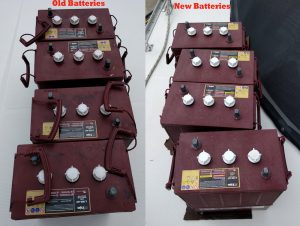Batteries – Out With the Old, In With The New
TrojanMSDS
Time for new batteries on Golden Glow before heading to the South Pacific. We admire those who have made the transition to LiPo Lithium batteries, but for a number of reasons we decided to stick with the same Trojan batteries batteries that had served us well in the past. LiPo requires many changes to the electric layout, and those batteries can be ruined if regulators on solar and wind generators malfunction even once and the batteries overcharge. This has happened to several other boats we know (although they don’t publicize the fact). One or two became stranded and in a real predicament because they couldn’t get replacement fuel cells fast – they had to be shipped and took weeks or months to arrive. And the boats couldn’t go back to the deep cycle battery format where they were stranded, and so were really in trouble. We like the comfort of knowing that Trojan’s far-reaching distribution network worldwide can help us should we ever develop a battery problem in remote areas as we sail around the world. We know we’ll be able to get service or replacements more easily than if we had chosen a lesser name or lithium.
Maintaining Strong Battery Health
Installing new batteries is just the beginning. They only give as good as they get. We baby our batteries, feeding them lots of solar, wind and if needed generator power to keep them nice and full. Here are some installation and maintenance guidelines for flooded deep cell batteries that we’ve learned over time.
Water Levels
We check their water and electrolyte levels regularly, usually twice a month because we sail in hot climates. Batteries use up water faster if the systems run at higher charging rates or with heavy discharging. As batteries charge, some water/electrolytes are converted to hydrogen and oxygen gas and seep out through the vent caps.
We want to keep the water level at about 1/4 inch below the vent tube. We replenish the electrolytes to the desired level level by adding distilled water. Losing electrolytes and replacing them with distilled water causes dilution of the acidity of the batteries, effectively reducing their capacity and performance. We add water only after we charge the battery to 100% or after we’ve completely equalized.
We keep a log by date of the checks and how much water we’ve added so we can keep track of usage trends and spot potential problems early. If a battery starts needing more water, it is typically a sign that it is failing.
Water levels are a delicate balance. If the plates inside the battery become exposed, that can cause irreparable damage to the battery, so if we had to, we’d add enough water to at least keep them covered before recharging.
Overfilling can cause problems too though. If the electrolytes overflow, it isn’t just a mess, it’s a dangerous mess.
We shipped our new batteries down from the USA via Tropical shipping. Batteries are “hazardous cargo” which required us to supply a Dangerous Goods Declaration and a Material Data Safety Sheet. When you read that document – TrojanMSDS – detailing the potential dangers of the batteries, you realize how very much you do not want to spill battery acid on you or your boat!
Checking Connections
Nuts and bolts on the batteries also need regular attention. We diagram and label each battery cell with a reference number and mark every battery (there are four) with where it sits in the battery box (e.g. port aft, starboard forward) to be sure all the terminal connections are made correctly.
We use flat washers to prevent the bolt and nut heads from digging into the soft lead terminals and copper cable lugs (but we don’t put them between the cable lug and the battery terminal). We also use split-type lock washer to help keep the bolted connection tight. They need to be tight enough to fully compress the split-type lock washer and flat washers. The bolt should be tight enough that the cable lug cannot be moved on the terminal when it’s pulled.
Battery manufacturers will specify torque values for their terminals. Typical torque levels for 1/4-inch hardware is 6 foot-pounds; for 5/16-inch hardware it’s 11 foot-pounds. Trojan lists its recommended torque and overall instructions for its batteries. Here are copies of Trojans’ recommendations – WP_BatteryCableGuide_0512 and TrojanBattery_UsersGuide
We use insulated tools so we don’t risk having a metal wrench accidentally cause a short circuit to the adjacent terminals. Accidental short-circuiting between battery terminals can damage a battery and result in severe injury— we we always use insulated tools and stainless-steel hardware to connect cables to the terminals.
After Rand installed our new batteries, he checked the terminal posts and cable lugs to be sure they wer clean prior to installing the connections, then he painted them with CRC Sta-Lube Copper Anti-Seize lubricant to prevent seizing due to high temperature, heavy load, vibration or corrosion.Finally, after that step, he re-tightened the cables.
Initialization Charging for New Batteries
After our new batteries were installed, we charged the battery bank fully and checked and recorded each battery’s voltage, specific gravity, and polarity to give us a basis for later comparison. This “initialization” or “activation” charge ensured that the battery cells start at an equal voltage and that all sulfation is removed from the plates.
Recharging & Equalizing the Batteries
One of the most important necessities to maintaining healthy, long-lasting batteries – at least for deep cell flooded batteries like ours – is to regularly charge the battery to a full state of charge. Ideally, this should be done once a week. No matter the reason, undercharging batteries can permanently harm them over time. When batteries are not fully charged, sulfate crystals form on the lead plates’ surfaces. This reduces the contact area between the lead and the electrolyte, decreasing the battery’s capacity. Sulfate crystal buildup can become an irreversible condition that gets worse and worse until the battery is unusable.
During our periodic maintenance checks, we measure and record our batteries’ voltage and each cell’s specific gravity. We know we need to equalize if there is a specific gravity difference of 0.025 or higher between cells.
Equalizing
Equalization is intentional overcharging to remove the sulfation from the battery’s plates. Equalization brings weaker cells up to parity with stronger cells and should only be done with flooded lead acid batteries. During equalization, the battery’s cells gases vigorously, mixing up the electrolyte and eliminating stratification. We have to closely monitor the electrolyte’s level and temperature — and be prepared to shut down the charging when the equalization is finished, or if the temperature exceeds 125°F (52°C). Many modern inverters/chargers and PV charge controllers have an equalization function, which allows the charging source to charge the battery for a timed period and achieve a preset, high-voltage set-point.
How to Equalize the Batteries
To perform an equalization charge on a flooded lead acid battery, these are the steps we follow:
- Charge the batteries through the bulk and absorb stages before starting the equalization process.
- Measure and record the voltage and specific gravity of each battery and cell. A battery meter is crucial to monitoring your battery bank’s electrical state.
- Choose the cell on each battery string with the lowest specific gravity reading as a pilot cell—these will be the cells tested to determine when equalization is complete.
- Check the electrolyte level in each cell to make sure the battery plates are covered.
- Initiate the equalization charge.
- Check and record specific gravity readings of the pilot cells every half hour.
- Check electrolyte levels to ensure that they never fall below the top of the plates.
- Check temperatures of the batteries’ electrolyte every 30 minutes to make sure it never exceeds 125°F (52°C). Stop equalization if this temperature is exceeded.
- Stop equalization when the specific gravity reading in the pilot cell stays constant for three readings.
- Water each cell to 1/4 inch below the vent tube and replace the caps.
Monthly Maintenance Checklist
Our battery monthly maintenance checklist consists of:
Battery/Inverter:
- Clean corrosion from battery terminals and cable ends.
- Clean tops of batteries.
- Clean the inverter fan filter.
- Check electrolyte levels, and add water if necessary.
- Keep track of how much water we add.
- Check to see if our lightning surge protectors are intact.
- Check our inverter for error and event indicators.
Battery Temperature Sensor—
- Once or twice a month we visually inspect the battery temperature sensor, its cable, and its connection to the inverter:
- Check the adhesion of the sensor on the battery case.
- Verify that the sensor is in the proper place on the battery’s side.
- Verify that the sensor is in an interior location in the pack or enclosure.
- Check for breaks, nicks, or tears in the cable from the battery temperature sensor to the point of connection at the inverter or charge controller.
- Make sure the battery temperature sensor cable’s inverter connection is not damaged or corroded, and that its protective insulation is still intact.
- Verify that there’s no dust, dirt, corrosion, or insects in the battery temperature sensor’s connector at the inverter.
- Verify that the battery temperature sensor is connected to the correct inverter.
- Verify a reasonable battery temperature is displayed, based on ambient or battery temperature.




Leave a comment